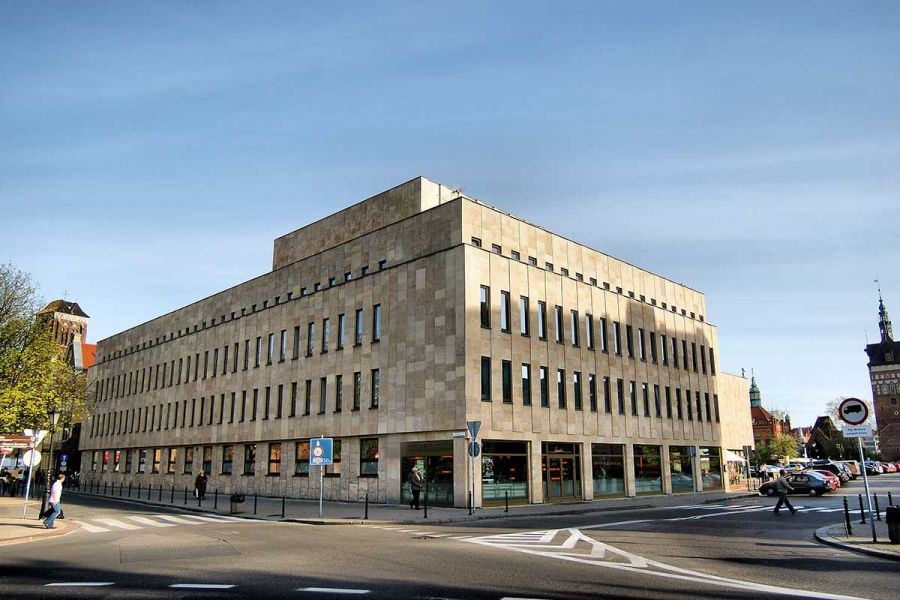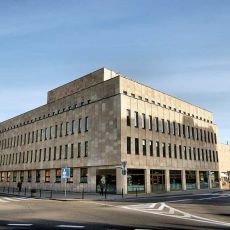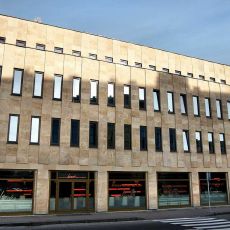Coast Theater
80-834 Gdańsk
tel.: 58 551 50 40
tel.: 58 301 13 28
e-mail: bilety@teatrwybrzeze.pl
Description
The area around this square for centuries was a place where the inhabitants of Danzig met with culture and entertainment. Already in the 16th century, there were buildings serving theatrical art, and the wooden theater established in 1600 resembled well-known English theaters, such as the Globe Theater in London or Swan-Theater, and was located in the area of the intersection of the present streets: Bogusławskiego and Podwala Przedmiejski. Joanna Schopenhauer wrote in her memories of wooden theater as an old wooden shack, which resembles a stable more than a temple of art. Indeed, at the end of the eighteenth century, depictions in the "wooden hut" were abandoned, turning it into a riding hall and it was decided to deal with the construction of a new, real theater.
This task was undertaken by the city architect Samuel Held, commissioned by the newly created company "for the construction and operation of the theater". Held made three successively rejected projects, the first of which completely covered the facade of the Armory, and the third provided for the construction of a theater at the Coal Market itself. Only the fourth, located in the place of the current theater, was accepted by the clients. In 1799 construction was begun, and the official opening of the Gdańsk theater took place two years later, on August 3, 1801.
The Municipal Theater, called the "coffee mill" by the inhabitants of Gdańsk (since 1933, the State Theater - owned by the Senate of the Free City of Gdańsk) underwent a thorough reconstruction of the main building in 1935 - the stage, foyer and auditorium were radically modernized at that time.
The last performance in the theater according to Held's project took place in July 1944. Burnt down in 1945, the building remained in ruins until the 1960s. The performances were staged at the Gdynia "barn" (in place of the current Musical Theater) and at the Grand Theater in Wrzeszcz - today's Baltic Opera. In 1966, a new headquarters was commissioned, implemented according to the design of Lech Kadłubowski. The ceremonial opening took place on January 7, 1967. Modernist solid with huge surfaces of glazing has a new nickname - "aquarium".
Currently, the Wybrzeże Theater has as many as five stages: the Big Stage and the Black Hall for them. Stanisław Hebanowski, Scena Malarnia, the Chamber Stage in Sopot and the Summer Stage located in Pruszcz Gdański.
DANZIGER STADTTHEATER
Carl Steinberg should be considered the first director of Stadttheater at Targ Węglowy. With his cause, Iffland's play was chosen for the inauguration of the new stage.
His successor, Jean Bachmann, was the director of the Gdańsk Municipal Theater in the years 1801-1811. It was thanks to Bachmann's activity that premieres of operas by Mozart took place in Gdańsk. He was not, however, a brisk manager - in his direction the theater fell into serious financial trouble, which on May 24, 1807 led even to the temporary closure of the theater and the release of all actors.
Gdańsk Huray, director in the years 1811-1819, attempted to draw Gdansk from the troubles. Huray tried to fill the audience by organizing numerous traveling shows, arranging lotteries and frequent redoubts - extremely popular mask evenings. At the same time, he did not forget about maintaining a high artistic level. On the stage at Targ Węglowy, viewers had the opportunity to see works by Goethe, Schiller and Shakespeare. Behind the directorate of Huray in Stadttheater, the works of 57 authors were staged, not to mention the numerous operas which in Gdansk often had their Prussian premieres.
The main merit of the next director, Adolf Schröder (1820-1831), was the drawing of eminent stars of the German theater to Gdańsk. Thus, Sophie Schröder, the support of the Vienna Burgtheater, visited the Motława River. The stars of the Gdańsk stage were also Carl La Roche from the Weimar Hoftheater, Friedrich Genée (later director of the theater), Charlotte Birch-Pfeiffer and Madame Cretingerst.
Gustav Heinrich Leopold Laddey was the director of the Gdańsk stage in 1838-1841. He took over the administration after nine months of interregnum. Laddey was widely regarded as a very mediocre director, and his term of office was sometimes called the fall of the Gdansk scene. In the years of his directing, he staged 38 dramatic plays and 8 operatic performances, in which his wife, talented actress and dancer Urlike Weiland created leading roles.
Friedrich Genée was the director of the Gdańsk theater in 1841-1855. His management was rated very highly, critics and the public acknowledged that thanks to him the theater reached the highest level in its history so far. At the Coal Market he staged almost 240 dramatic plays and 50 operas. The repertoire included not only works of drama classics, but also lesser-known authors gaining popularity, such as Dumas, Gutzkow, and Laube. Taking care of the high level of performances, Genée brought to Gdańsk the stars of the first magnitude, including Lola Montez, an excellent dancer from Berlin and members of the famous acting Devrient family from Dresden.
The later directorates of the Gdańsk theater have not made any special mention in the field of art. Like the other German scenes at the Coal Market, the operetta and shoddy vaudeville reigned supreme. Even the efforts of Georg Lang (director in 1870-1878), who tried to introduce more valuable positions of Wagner and Verdi to the theater's repertoire, did not help. Until the 1930s, Danziger Stadttheater stood out only in a deplorable state of finances and gradually settled in ruin. It was not until the directorate of Erich Orthmann (1933-1935) that the long-awaited reconstruction of the theater took place.
In March 1945, the theater, as well as the entire historic Gdańsk, ceased to exist.
COAST
The first post-war director of the theater was Iwo Gall. He led the Tri-City scene until 1949 and decided to decide on the artistic face of the theater. During his four-year-long directorship, he took part as a producer, director or set designer in the preparation of more than half of the then premier. Wybrzeże Theater inaugurated its post-war poetic and metaphorical activity, premiere performance of Tadeusz Gajcy's HOMER AND ORCHIDEA in his direction (1946). The experimental character of the theater was testified by his subsequent productions: BALLADYNA (1947) and MARIA STUART by Juliusz Słowacki (1949), CHERRY SAD Antoni Chekhov (1949) and the most-famous show HOW WE WELCOME TO SHAKEYS (1947) in a perfect way combining the Elizabethan tradition with modernity.
In the early 1950s, after Iwo Galla left, the socialist realism with its rather flat naturalism flourished on the Wybrzeże Theater stage. A typical example of this aesthetics was the premiere of Leopold Rybarski's production drama W STOCZNI directed by Wiktor Biegański (1951).
In the years 1955-1979, the director of the Wybrzeże Theater was Antoni Biliczak, who chose the role of an efficient organizer and stage administrator. During his long-term management of the shape of the theater, the next artistic managers decided, among others Lidia Zamkow (1953-1954), Zygmunt Hübner (1958-1960), Tadeusz Minc (1967-1969), Marek Okopiński and Stanisław Hebanowski (1969-1980).
Lidia Zamkow came to the Wybrzeże Theater from Krakow with a group of young actors, including Kalina Jędrusik, Zbigniew Cybulski, Jerzy Goliński, Leszek Herdegen and Bogumił Kobiela. Zamkow realized here the Polish premiere of Maksymilian Gorki's BARBARZYŃÓW / BARBARZYŃÓW / THE BARBARZYŃÓW / Maxim Gorky (1953) and VISWARSTY VISINSTY'S OPTIMOREST TRAGEDIA (1955), which proved that the art of revolution can be exposed in an unchastic way - with expressive collective scenes and the marking of human individuality in the historical process. Jerzy Goliński prepared, on the other hand, PAN PUNTILA and his servant MATTIE, Bertolt Brecht with a great, metaphorical set design by Wojciech Krakowski (1955).
After a short period of stagnation and average theatrical production in Gdańsk, Zygmunt Hübner appeared, who proposed open and contemporary theater. He composed the repertoire corresponding to high requirements, trying to ensure that he had a definite problem and artistic expression. Hübner invited such directors as Bohdan Korzeniewski, Konrad Swinarski and Andrzej Wajda to cooperate with us. The latter on the stage of the Wybrzeże Theater realized his directorial debut - HAT FULL OF RAIN Michael Vinzenze Gazzo with Mirosław Dubrawa and Zbigniew Cybulski (1959) - a revealing performance filled with expressive, film acting. In the shaping of the repertoire, Hübner emphasized contemporary drama, mainly English and American. Swinarski directed the Taste of Honey by Shelagh Delaney (1959) - the performance is clasped in a poetic and metaphorical brace, but in a very decisive way portraying social problems. Similarly sharp and passionate, but at the same time very clear and disciplined was the performance of Jerzy Goliński - FUN AS NEVER William Saroyan (1960) with the outstanding role of Edmund Fetting. Hübner himself said goodbye to Eugene Ionesco's NOSOROŻEC by Eugene Ionesco (1960).
At the time when Jerzy Goliński directed the stage, many authors from the German language area were included in the repertoire. Played, among others Bertolt Brecht, Friedrich Dürrenmatt and Max Frisch. Goliński was a staging director who liked the formula of the journalistic and political theater, often based on fact-assembly. In this way he realized, among others FRANKA V Dürrenmatta (1962).
Another important project on the Gdańsk stage is the TRAGEDIA ABOUT THE GOD AND THE ŁAZARZ by Anonim Gdański, directed by the new artistic director of the scene of Tadeusz Minc (1968) - a mysterious Baroque performance different in spirit and atmosphere from the Dejmek staging of Old Polish texts. And shortly thereafter, one of the greatest performances of the Coast, a great manifesto of the poetic theater - Maciej Słomczyński's ULISSES based on James Joyce directed by Zygmunt Hübner with the set design by Lidia Mintycz and Jerzy Skarżyński and the music of Stanisław Radwan, with the great acting creations of Halina Winiarska as Molly and Stanisław Igara Blooma (1970).
The 1970s under the artistic direction of Okopiński and Hebanowski brought further repertoire changes. On the Coastal stage, literature on moral and existential issues began to dominate. Hebanowski directed Samuel Beckett WAITING FOR THE GODOTA (1970), Maciej Prus directed Adam Mickiewicz's DZIADY / AWESOMES (1979), and Andrzej Wajda and Maciej Karpiński prepared THE CASE OF DANTON Stanisława Przybyszewska (1980).
In the 1980s, Ryszard Major showed his controversial work on the Gdansk stage by directing the drama of Witold Gombrowicz in the tone of carefree jesters: IWONA, KSIĘŻNNICA BURGUNDA (1977), WEDDING (1982), OPERETKA (1984). One of the most interesting achievements of the theater in this period was Krzysztof Babicki's CHRISTMAS productions: CHERRY SAD (1985) and THREE SISTERS (1995) and productions by KORDIAN Juliusz Słowacki (1982) and ARKADIA by Tom Stoppard (1994).
From 2000 to June 2006 Maciej Nowak was the director of the Gdańsk stage. During his management at the Wybrzeże Theater appeared STM, or Szybsza Teatr Miejski - a series of performances played in private apartments and public spaces inspired by the idea of documentary theater. As part of STM, inter alia, A MEMORY OF THE DEFICIENCY of Anna Łojewska directed by Romuald Wiczy-Pokojski (2005). The most important realization under the management of Nowak should undoubtedly be the controversial and groundbreaking Dejan Dukovski's BECZKA PROCHU directed by Grażyna Kani (2002).
TODAY
In 2006, Adam Orzechowski became the director of the Wybrzeże Theater. Teatr Wybrzeże is currently one of the most well-known and respected places on the theatrical map of Poland. Over 100,000 spectators visit us annually. Our performances are hosted at the most important festivals in Poland, including at the Warsaw Theater Meetings, the Divine Comedy, and the Premiere Festival. The Wybrzeże Coast's artistic team is the laureate of the most prestigious Polish theater awards, including Awards Konrad Swinarski for Grzegorz Wiśniewski for DUSTERS OF GODS, Aleksander Zelwerowicz for Dorota Kolak and Mirosława Baki for the creations in the play WHO ARE THE BOY OF VIRGINIA WOOLF? and Paszportu Polityki for Ewelina Marciniak, among others for DAMA'S PORTRAIT.
PRICE LIST:
LARGE SCENE, SCENERY SCREEN, BLACK ROOM
Normal: PLN 30 (Tues, Wed), PLN 40 (Fri, Sat, Sun)
Reduced price: PLN 25 (Tues, Wed), PLN 30 (Fri, Sat, Sun)
Balcony and side galleries - places with worse visibility (Large Stage): PLN 22 (Tues, Wed), PLN 25 (Fri, Sat, Sun)
Group tickets (over 10 people): normal: PLN 25 (Tues, Wed), PLN 35 (Fri, Sat, Sun), reduced: PLN 25 (Fri, Sat, Sun), PLN 22 (Tues, Wed)
Entry to free places: PLN 20
CHAMBER SCENE
Normal: PLN 45
Reduced price: PLN 30
Group tickets (over 10 people): normal PLN 40, concessions PLN 25
Entry to free places: PLN 20
MARIA STUART
Normal: PLN 50
Reduced price: PLN 40
Balcony and side galleries (Large Stage): PLN 40
Entrance cards for stairs: PLN 30
Location
Św. Ducha 2, 80-834 Gdańsk
































Comments
comments powered by Disqus